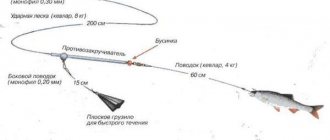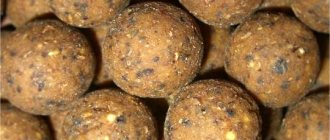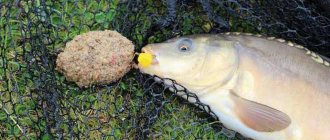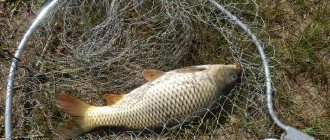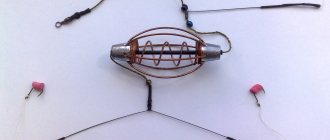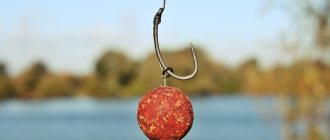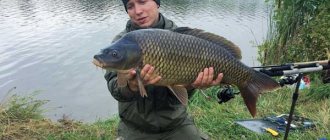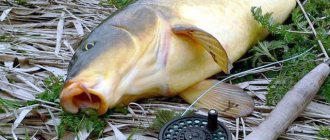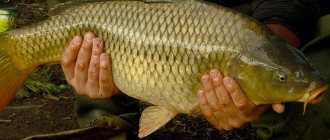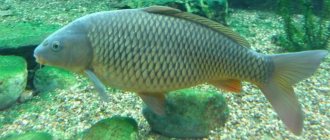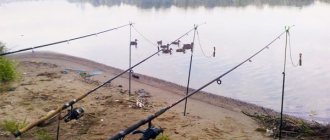What weather should you catch carp in?
The weather does not greatly affect the activity of carp when catching it with bottom gear, both on a small lake from the shore and on a large reservoir from the bridge. We must take into account:
- Donka for carp is most effective in the summer months, when the water has warmed up to a temperature of more than 20-220C. At the beginning of summer, before the heat sets in, in clear, warm weather, carp can bite throughout the day;
- In the middle of summer, with the arrival of heat, due to an increase in water temperature and a decrease in the oxygen content in it, carp becomes inactive during the day, hiding in snags, in the channel ditches of reservoirs, under steep banks at great depths. The fish are most active at this time in the morning and evening hours. Daytime activity can be observed when the heat subsides, the onset of warm, windless, cloudy weather with short rains;
- At the end of summer and beginning of autumn, the water temperature gradually drops, and the carp begins to become active not in the morning, but as the water warms up, from 9-10 o’clock. At this time, it is better to catch carp in clear, windless and not hot weather;
- In mid-late autumn, carp activity is very low - the fish become active only after a long and steady warming. Carp bite in the fall, usually in the afternoon.
Carp donka
On a small river, a long and powerful long-distance casting rod, which is used by carp fishing specialists, is not required. Meanwhile, quite large carp can live in a small river, as I managed to verify a couple of times over the past few days of June.
The first time I learned about the presence of large carp in the section of the river where I usually caught roach and bream (you can read here), I learned from the characteristic bite on the feeder, on the hooks of which Bonduelle corn was planted with red maggots. In the morning, a rather plump roach occasionally pecked, and then, around five o’clock, everything began to calm down, as usually happens in this place. All morning fishing usually took place from two o'clock to five, rarely until six o'clock. And so it was this morning.
I started to get ready to go home and it seemed to me that I hit the feeder rod with my boot. Why did it hit me... properly, I kicked it!.. But I didn’t touch the tackle, much less kick it. Meanwhile, the similarity was complete. A sharp blow that made the rod jump on the stand, a short jingle of a bell and it was all over. I took the tackle out of the water and discovered that there was no leader with two leads. The fish probably didn’t even notice that something was holding it and just moved on, breaking the line. By all appearances it was a carp.
Soon the carp reminded me of itself, but already from the words of a spinning angler who came ashore to me when I was catching roach in another place downstream. In a conversation, a guy with a spinning rod told how he had just hooked a lure rod of an angler who asked him about it. Somehow he picked up the tackle and pulled it towards himself. After powerful and short resistance, the rod was pulled out of the water with the line already torn off. It turns out that the rod was dragged away by a fish exactly in the place where the carp destroyed my feeder the last time. In a word, the picture became clear. A carp lives in that place and you need to catch it.
I didn’t risk the rods and built cunning donks for catching carp, so that I could fish with a traditional feeder and put special gear for carp nearby. The donks turned out to be simple, light and, I hope, functional.
Fishing technique
In order to use bottom gear for carp fishing most productively, you should correctly perform such basic techniques as casting equipment, hooking, and fishing:
- Casting a donkey is done vertically. You should hold the rod with both hands, place your legs slightly wider than your shoulders, and stand slightly sideways. First, we lift the rod vertically, and placing it as far behind the back as possible, with a sharp whipping movement, returning it to its original position, we cast. The line with the equipment should be released at the moment when the form, describing a semicircle when moving from behind, is as parallel to the surface of the earth as possible.
- Installation of gear and alarm. After casting the tackle, we place the blank on the holder, reel in the slack and, after making a few turns of the reel, create such tension on the cord or fishing line that the tip of the blank is in a slightly bent state. We attach the bells to the top or the second knee from it; swingers, pendulum alarms are secured between the reel and the first throughput end of the butt leg of the rod. We attach simple bells to a fishing line coming out of the tulip of the rod in such a way that the alarm attached to it creates a slight slack.
- Sweeping. You should hook when the alarm is activated for a long time and there are strong jerks, visually observed at the tip of the form. Hooking is performed by briefly and sharply lifting the rod up from the stand. You should not make a sweeping and very strong hook, which can either tear the soft lips of the fish or pull the hook with the nozzle out of the fish’s mouth.
- Fishing. Small carp should be fished out quickly. When fishing, larger specimens should first be slightly tired on a line stretched like a string, and only then slowly pulled to the shore, where it must be quickly placed in a landing net with a large bucket and a strong handle.
Groundbait and spot feeding
Catching carp with a donk feeder involves using a feeder. Bait used for feeder carp fishing can be not only purchased, but also made independently. Of the baits offered by stores, the most effective are:
- MINENKO PMbaits CARP;
- DUNAEV Premium Carp Carp;
- Traper Big Carp;
Self-prepared baits for carp fishing usually include:
- Dusting components. The base is breadcrumbs, ground seeds, cake;
- Heavy particles - canned corn, peas, maggots, bloodworms, chopped worms;
- Flavorings: vanilla, garlic, honey, special carp additives.
The technique of using bait when catching carp on bottom gear with a feeder includes:
- Feeding - using a larger and heavier rocket-type feeder filled with bait, we make several feeding casts at the intended fishing point. After the first cast, it is advisable to clip the cord or line so that you can continue casting to the same point.
- After 3-4 feeding casts, we wait about 25-20 minutes and, having filled the feeder with bait, placing the bait on the hooks, cast to the feeding point.
How to make donka for carp
You can make bottom tackle for carp fishing with your own hands, following simple instructions:
- We pass the fishing line through the rings of the blank and fix it on the spool of the reel;
- Under tension, we wind 200-250 m of fishing line onto the spool;
- Leaving unwound a piece equal to two lengths of the form at its end, we proceed to installation of the type of equipment most suitable for certain conditions.
Also, for carp fishing, you can assemble a classic bottom tackle on a large reel:
- To do this, we cut out a long and large reel from plywood, 20-25 cm long;
- We attach the end of a fishing line or cord to it;
- We wind 100-150 meters of fishing line or cord onto the reel;
- Stepping back from the end about 10-15 cm, we make a small double loop on the fishing line and tie a leash 15-20 cm long with a large and strong carp hook No. 6-8 hook to it;
- Having retreated 25-20 cm from the first leash, we make the second leash in the same way;
- To the end of the fishing line we tie a nylon thread 25-30 cm long with a flat sinker weighing up to 150-200 grams at the end;
- For such a line we choose a thick line, with a cross-section of 0.35 mm, for leashes we use monofilament with a thickness of 0.18-0.2 mm or a braided cord 0.1-0.12 mm.
The advantage of such equipment, compared to feeder equipment, is its compactness, the disadvantage is the difficulty in landing large fish in the absence of a rod and reel.
Donkey rigging
The equipment of the bottom tackle is a varied combination of the relative position of the sinker, feeder, leashes with hooks and connecting and anti-twisting elements. When fishing for carp, the following types of rigs are used:
- Inline;
- Sliding;
- Helicopter"
Each of the equipment is used in certain conditions. So, for example, with a sliding rig, carp should be caught in reservoirs with strong fishing pressure, in lakes with a muddy and marshy bottom.
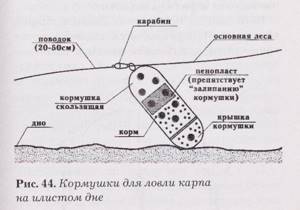
Many fishermen, while modernizing their bottom gear, also improve the rigs they use, making the gear more durable, sensitive and catchy.
Inline
This catching equipment is used on reservoirs with a hard, non-silted bottom. It is assembled very quickly and simply:
- Cut a piece of leadcore 60-80 cm long;
- We make loops at its two ends using a mounting needle;
- We install a quick-release swivel on one of the hinges;
- Using a mounting needle, we hook the leadcore to the second loop and pass it through the inner sleeve in a pear-shaped sinker weighing up to 120-150 grams;
- We recess the swivel with quick release inside the sinker sleeve;
- We attach a leash made of braided cord with hair accessories to the quick release.
This equipment is one of the simplest and does not require special skills for installation.
Its advantages include high reliability and frequent self-hooking of carp. The disadvantages are the low casting range and the inability to use on reservoirs with a muddy, marshy bottom.
Sliding equipment
Classic carp bottom equipment, assembled as follows:
- At the two ends of a piece of leadcore 80-90 cm long we make small loops;
- We attach a swivel with a quick release to one of the loops with a cape;
- Using a mounting needle, we place a locking plastic sleeve on the leadcore;
- We rest the bushing against the quick-release swivel;
- By pulling the leadcore from the opposite end, we recess the swivel into the bushing;
- We put a plastic ring with a clasp on the leadcore;
- 20-30 cm above the fastening point of the quick-release swivel, place a rubber stop bead on the leadcore;
- We attach a pear-shaped sinker weighing 100-120 grams to the clasp;
- We attach a leash with hair accessories to the quick release.
Such installation, unlike inline, does not promote self-hooking of carp, but it can be used in reservoirs with a muddy, marshy bottom. The casting range of such equipment is much greater.
Helicopter
The longest-range of all carp bottom gear, assembled as follows:
- At the ends of the leadcore section we make two loops;
- To one of the loops we attach a fastener with a pear-shaped sinker weighing 100-120 g;
- We close the place where the fastener and the leadcore loop are attached using a silicone sleeve;
- We put a swivel on the leadcore with a quick release at the end;
- We fix the movement of the swivel along the fishing line with a rubber bead;
- We attach a monofilament leash with a hook and hair rig to the quick release.

The advantages of such equipment are its high casting range and the ability to fish in reservoirs with a significant layer of silt at the bottom. The disadvantage is the frequent twisting of the leash by the leadcore when diving the gear to a depth of more than 5-6 meters.
Live bait donka
I have already successfully and repeatedly used an analogue of such a carp bottom here, on this sandy bank, and caught pike. But the base was a plastic bottle. And such a basis turned out to be short-lived. The bottle quickly became deformed. In addition, it took up more space than a piece of PVC pipe. The strength of the tube is beyond doubt.
In fact, the device here is the same as on a carp bottom, only a metal leash with a double is tied above the sinker.
I recommend to read:
Zherlitsy for a small river - The approach of spring.. Where to place the zherlitsy? What changes have to be made to the equipment of the vents? Why you shouldn't look...
How to make bait for a feeder with your own hands
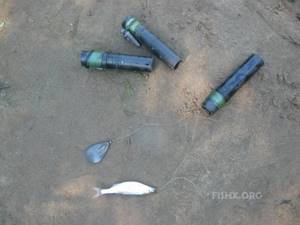
Share with your friends!
Choosing a fishing line for carp for bottom tackle
For bottom carp tackle, you can use both monofilament fishing line and braided cords:
- When fishing in small reservoirs, ponds and stakes, where the weight of the carp does not exceed 2-3 kg, you can use high-quality monofilament with a cross-section of 0.27-0.35 mm;
- For large reservoirs, as well as ponds where trophy fish weighing over 6-8 kg are found, braided cords with a cross-section from 0.16 to 0.2-0.22 mm should be used.
When choosing a fishing line, preference should be given to special carp models that are characterized by high strength and durability.
Catching carp on a donk with a feeder
Catching carp on a donk with a feeder - a feeder - involves the use of appropriate gear:
- The rod is used with a length from 3.6 to 4.2-, 4.5 meters with a fast action and a cast of over 100 g;
- The reel is inertia-free, with a size of at least 4000-4500, with 3-6 bearings and a gear ratio of no more than 5:1;
- When fishing for carp on a feeder, a strong cord with a cross-section of 0.18-0.22 mm is used, monofilaments are used even thicker - 0.25-0.35 mm;
- Feeders - rectangular and round, metal, weighing from 60-80 to 90-100 grams.
Catching carp with this tackle is effective in reservoirs and large lakes with a small layer of silt at the bottom. The best season for catching carp with this tackle is mid to late summer.
Feeders for various fishing conditions
When fishing for carp using bottom gear, both feeder and specific carp feeders are used:
- Open - without plugs on both sides;
- Semi-closed - there is a plug at one end that prevents feed from spilling out to the bottom;
- “Method” type feeders are flat, covered with bait, in which hooks are hidden.
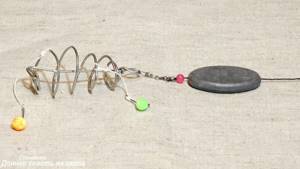
The use of one type or another depends on the structure of the bottom and the presence of current:
- When fishing for carp on rivers with a small current and in places with a very muddy bottom, semi-closed type feeders are used so that when the equipment falls to the bottom, the bait is not quickly washed out by the current of water or does not get stuck in a layer of silt.
- Open type feeders, as well as the “method”, are used on ponds and lakes with standing water and a relatively hard bottom.
Montages
The choice of rig for catching carp on a donk depends on:
- fishing conditions;
- the presence of a current in a reservoir;
- distances;
- way of feeding.
If fishing is carried out in a well-fed place, additional means of delivering bait such as feeders are not needed. If you have to cast while fishing, a rig is tied using a spring feeder or a plastic feeder, so that after each cast an additional portion of bait gets to the fishing point.
Installation for fishing on the current
To connect a rig for fishing in the current you will need:
- leash with hook;
- sinker with a through hole;
- swivel;
- stop bead or rubber stopper.
The equipment is knitted on a separate piece of fishing line 40-50 cm long and mounted on the base using the loop-to-loop method.
Installation procedure:
- tie the swivel to the fishing line;
- put on the rubber stopper and lower it to the swivel;
- put a sinker on the line;
- put on another stopper;
- at the free end of the fishing line, make a loop for attaching to the base;
- tie the leash to the swivel.

The result is a sliding installation, and the sinker moves freely along the fishing line, limited on both sides by stoppers. After the fish takes the bait, it does not feel resistance for several seconds, because the line glides freely. Only after the load rests against the upper stopper, the soft tissue is caught and all that remains is to bring the fish ashore using a boat, or manually.
The length of the leash is 20–30 cm and soft leash material or cord is used for tying it. This is important, since a leash made of monofilament line or fluorocarbon is too hard and may not be liked by the fish, and hooking on soft leashes is more reliable.
It is not necessary to take expensive leash materials for tying leashes; a budget cord will also do, the main thing is that its breaking load is sufficient for calmly playing the trophy.
When fishing from a long distance, you should not tie several leashes. The fish will still find a hook with a nozzle in a pile of food, and an extra leash becomes a hindrance when fishing, especially from a distance.
The weight of the load must be such that the equipment is not carried away by the current, and reliable self-notching occurs. But a sinker that is too heavy should also not be used, because it will only complicate the task of landing fish due to the additional weight.
Installation with a spring feeder for fishing on a standing pond from the shore
Casting rigs are tied on a fishing line or cord, the thickness and strength of which is higher than that of the base.
This is necessary so that in the event of a snag, only the installation itself comes off, and the base remains intact. Usually a break occurs at the junction of the rig with the base, and to continue fishing all that remains is to tie on a new rig.
To make the installation you will need:
- a piece of thick fishing line from a cord 40–50 cm long;
- spring feeder;
- two swivels;
- two leashes with hooks.
Knitting order:
- tie a swivel to the end of the fishing line;
- put a feeder on the fishing line;
- at a distance of 20 cm from the bottom one, tie the second swivel;
- make a loop at the free end to connect to the base;
- tie the leashes to the swivels.

The result is an installation with a spring, and the leashes with hooks are located at a distance from each other, which increases the chance of a bite. The spring feeder moves freely along the line, and notching occurs when it rests on the upper swivel.
The weight of the feeder is selected depending on the fishing distance, so that it is convenient to cast, but large enough to catch fish. In this case, it is not the net weight of the feeder itself that is taken into account, but the weight with bait. If the spring feeder is not loaded, during installation it is necessary to use an additional sliding sinker, otherwise the notch will be unreliable.
The size of the spring is chosen at your own discretion, the main thing is that the finished filled feeder is convenient to throw at a given distance. There is no point in placing more than two hooks; their location at the top and bottom of the feeder is most attractive to fish, and extra leads only get tangled and interfere with fishing.
Donkey complete set
In addition to fishing line and equipment, the most important elements of classic carp bottom gear are the reel and rod.
Rod
To catch carp with various bottom rigs, with the exception of feeder rigs, special carp rods are used, which are distinguished by their strength, reliable design, forward reel seat 3.3-4.2 m long with a test weight of up to 100-120 g.
Coil
- Case material - alloy or durable carbon fiber;
- Size - from 3000−4000 to 5000−6000;
- Friction - rear;
- Number of bearings from 4 to 6−7;
- Gear ratio 4−4.6:1;
- A bayrunner is required;
- Weight - 250−300g.
Rod and reel set
Fishing for carp requires the use of powerful rods and reels that can cope with the resistance of large fish. Even in light class gear there are series specially designed for extreme loads when fishing. It is better to choose reels with a low gear ratio, as they have more traction.
Rod classes
There are several classes of rods used for carp fishing. Based on the fishing method, a distinction is made between feeder and carp rods.
Feeder rods
Feeder rods are designed for fishing with a feeder. Their characteristic feature is a brightly colored sensitive tip with a large number of throughput rings, which displays bites.
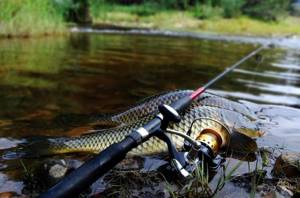
Feeder rods for carp fishing
Rods for feeder fishing are divided according to the weight of the feeders being cast:
- light - with a dough of up to 60 g, used for catching relatively small fish in reservoirs without a current or with a slight current;
- medium - with dough up to 90 g - the most versatile option. These rods cope with most fishing conditions and allow you to catch quite large fish;
- heavy – with dough up to 120 g;
- super heavy – the weight of the thrown feeders is from 120 g.
The niche for using heavy and super-heavy feeders is fishing in very strong currents, casting from 100 m and catching very large fish such as trophy carp, grass carp, silver carp or catfish.
Carp rods
Carp rods are designed for long and ultra-long casting of heavy equipment. The markings of carp rods are different from those of feeder rods. They indicate the weight under which the rod tip will bend at a right angle. Weight is indicated in pounds (lb):
- Lightweight rods with a weight of 2 to 3.5 lb allow you to cast equipment weighing up to 120 g. Their niche is fishing in small reservoirs at short distances.
- Medium ones have a dough of 3–3.5 lb. These are the most versatile rods, suitable for most conditions and casting equipment up to 150 g;
- Heavy rods with weight starting from 3.5 lb are designed for ultra-long casting of equipment weighing from 150 g.
Read more
Features of fishing with an elastic band
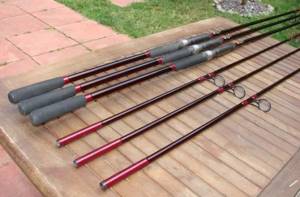
Types of carp rods
In addition to power, rods differ in their construction:
- parabolic (slow) – the entire rod blank works under load. Their advantage is the ability to well dampen the jerks of fish when playing;
- semi-parabolic – rods in which approximately half of the blank works. This is a kind of universal option;
- fast action rods. When casting and retrieving these rods, only the tip works. This allows for precise casting and better hooking of fish over long distances.
In addition to rods designed for fishing, there are marker (for measuring the bottom topography) and spod (for casting bait) rods.
When choosing gear for bottom carp fishing, it is better to avoid telescopic rods. Their only advantage is ease of transportation; in all other respects they are inferior to plug rods.
Feeder rod material
Rods for feeder fishing are made from three types of materials:
- Fiberglass. This material has been used for quite a long time and is obsolete. Fishing rods made of glass are durable, but today they are considered heavy and insensitive. However, it should be noted that for feeder fishing this is not a critical drawback. So the use of fiberglass rods as budget gear is quite acceptable. In terms of their characteristics, they are significantly superior to cheap telescopic rods that are used for catch fishing.
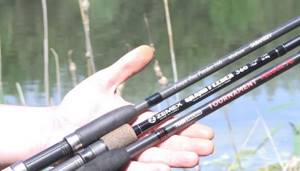
Rods for feeder fishing
- Carbon fiber (graphite, carbon). Today it is the most modern material for making fishing rods. Carbon fiber rods are characterized by minimal weight, high strength and elasticity. Their disadvantages are the relatively high price and some fragility.
- The composite is a combination of carbon and glass fiber bonded together with a special resin. Composite rods are a compromise between the options described above. They can be recommended to beginners or anglers who fish with bottom gear from time to time.
Reels for feeder fishing
For feeder fishing, only spinning reels are used. The size of the reel is chosen for a specific fishing rod, so that the tackle is balanced, that is, the center of gravity of the rod with the reel is as close as possible to the reel seat. Typically, coil sizes 2500–4000 are used. The remaining requirements for the feeder reel are the same as for reels for other types of fishing - even laying of the line, smooth adjustment of the friction brake, high quality assembly of the mechanism.
For carp fishing with a feeder, it is better to use more powerful reels. It is desirable if they are equipped with a beytraner - a mechanism for disabling the clutch.
Read more
How to make a “crucian carp killer” tackle: DIY production and fishing techniques
It is important to remember that when power casting heavy equipment, the baitrunner must be turned off (the reel spool should not rotate), since the spool turned under the action of the sinker will give up the fishing line, which, in turn, can seriously injure the angler.
